#eze Nri
Text
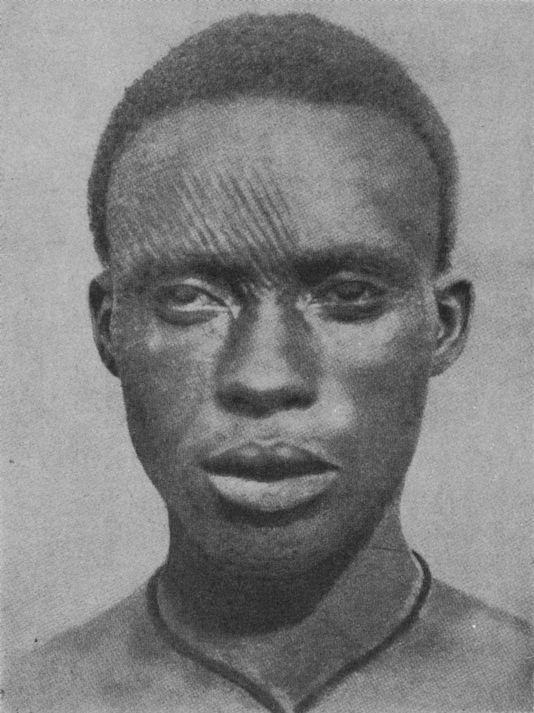
Ichi was a form of facial ritual scarification worn by mainly men of the Igbo people of Nigeria. The scarification indicated that the wearer had passed through initial initiation into the aristocratic Nze na Ozo society, thus marking the wearer as nobility. Echoes of this tradition are found in the contemporary derivative word Ichie, which denotes a member of a class of titled chieftains amongst the Igbo.
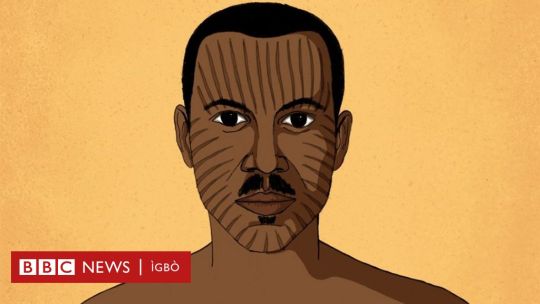
The scarification was found among men in the Awka-Nri areas and among a few women in the Awgwu and Nkanu areas. Its wearers were authorized to perform ritual cleansing of abominations and to confer titles on people. People with facial marks were regarded as Nri men and were less likely to be taken as slaves. Other parts of Igbo land may have started wearing Ichi as a result of this. There are two styles; the Nri style worn in the Awka-Nri areas, and the Agbaja style worn in the Awgwu and Nkanu areas. In the Nri style, the carved line ran from the center of the forehead down to the chin. A second line ran across the face, from the right cheek to the left. This was repeated to obtain a pattern meant to imitate the rays of the sun. In the Agbaja style, circles and semicircular patterns are added to the initial incisions to represent the moon. These scarifications were given to the representatives of the eze Nri; the mbùríchi. The scarifications were the Nris' way of honoring the sun that they worshipped and was a form of ritual purification.
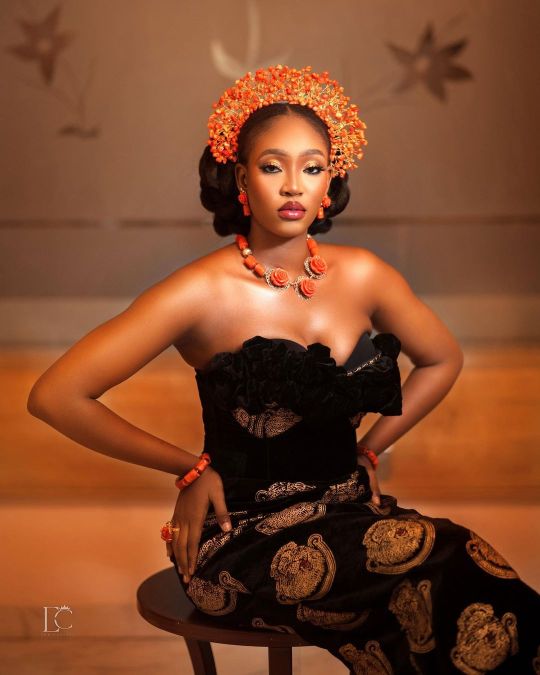
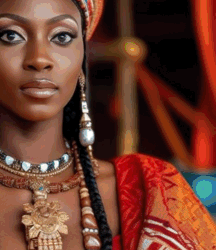
#african#afrakan#africans#kemetic dreams#brownskin#afrakans#brown skin#african culture#afrakan spirituality#ichi#scarification#tribal art#tribal tattoo#nzi#igbo#igbo culture#Nze na Ozo#Nri#Awka-Nri#eze Nri#mbùríchi#titled chieftains#nobility#Nigeria
38 notes
·
View notes
Text
Democratic Governance in Pre-Colonial Igboland: A Historical Perspective
Prior to British colonisation in the 20th century, the Igbo people in southeastern Nigeria lived under a republican consultative assembly. Exceptions included the Priest-Kings of Nri and Aro, as well as notable towns like Onitsha, where the Obi ruled as king, and Arochukwu with the Eze Aro.
An “Acephalous” Political System
The Igbo pre-colonial political system was termed an “acephalous…

View On WordPress
2 notes
·
View notes
Text

The Igbuzo (Ibusa) Kingdom:: Tracing the Roots of a Brave Igbo Community in Delta State, Nigeria"
Igbuzo, also known as Ibusa, is a vibrant Igbo community nestled in Delta State, Nigeria. Its roots can be traced back to around 1450 when waves of Igbo migrants embarked on a journey westward, ultimately leading to the formation of Igbuzo.
The name "Ibusa" is derived from "Igbo bi n'ụzọ," meaning "Igbos that live by the wayside" or "Were you the first to settle here?" This moniker was bestowed upon them by neighboring communities such as Ogwashi-Uku, Asaba, Oko, Ilah, and Okpanam, as well as European missionaries who struggled to pronounce the community's original name.
Historians believe that a group of settlers who embarked on a journey from Benin alongside Ezechima, heading eastward, may have found their final settlement in Igbuzo. It is speculated that these settlers, either due to illness or a lack of interest in continuing their journey, assimilated into the existing Umejei and Edini groups in Igbuzo.
Ibusa comprises two distinct units: the Umejei and Ogboli settlements. According to oral history, Umejei Nwa Eze Isu, the prince of Isu, was involved in a wrestling bout that resulted in the death of his opponent. Traditionally, this act was considered an abomination punishable by death. However, Umejei's father, the king of Isu, commuted his son's sentence, and Umejei was exiled with a gourd given to him by his father. He was instructed to settle wherever the gourd dropped, leading him to establish Igbuzo at the present site of Ani-Oshe in Omeze.
In another tale, Odaigbo of Nshi (Nri) had relations with one of his father's wives, which usually carried a mandatory death sentence. However, Eze Nshi spared Odaigbo's life and instead exiled him, accompanied by his father, mother, and younger brother, Edini. Each of them carried a pot and charms, instructed by Eze Nshi to settle wherever the pot fell. Edini's pot landed at Ani-Nshi (Nri) Ogboli in Ibusa, while Odaigbo's pot dropped at the current site of Ogwashi-Uku, where he settled. The groups of Edini and Umejei eventually merged to form Ibusa, with the Ogboli community becoming part of the larger Nri (Nshi) community.
Ibusa is renowned among the Igbo and Anioma people of Delta State for their courageous spirit, often described as "Isu (Igbuzo) fu ogu ju nni," meaning "Ibusa people who refuse food to fight wars." This statement exemplifies their bravery in times of conflict. Researchers are currently delving into the history of wars fought by the Igbuzo people, particularly in the homes of their kinsmen in Nnewi, Anambra State, to uncover any historical connections between the two communities.
43 notes
·
View notes
Text
Now let us get the origin of the 4 Market days in Igbo Tradition. The 4 market days comprises the EKE, ORIE, AFOR and Nkwo who is the last born child, they were originated from NRI during the region of Eze Nrijiofor 1 (1300-1390 AD) and the Fifth on the chronology of the Nri traditional throne or Succession. During this period, 4 wise men visited the palace of Eze nrijiofor and pretended to be deaf and dump and never said their names nether their mission to the palace on arrival, each came with Nkata which literally means Basket, they were taken to the visitors chamber by the Adamma who was the king's servant, later in the evening, the Eze Nrijiofor went to see them but they didn't respond warmly to him and also didn't acknowledge his greetings. Oji (kolanut) was presented to them but they didn't alter a word in acceptance or rejection of the kolanut (oji), late in the night, Eze nrijiofor 's soothsayer sent a rat to disturbed their sleep when the rat went to the first basket belonged to EKE and started to nibble at it, Orie woke up and called " EKE wake up! A rat is trying to get your basket" eventually, EKE woke up the rat ran away, the rat repeated the trickish manner to other baskets to ascertain their names "Anuta Akara Eze". In the morning, Eze nrijiofor went to them and started performing the Oji ututu on that process, he mentioned their names by saying Eke taa oji, Orie taa Oji, Afor taa Oji and Nkwo taa Oji respectively, the visitors who were referred to as "Ndi biala eji ekwu okwu" were astonished and request for water to wash their hands and faces and accepted the kolanut offered by Eze Nrijiofor, after chewing the kolanut, they brought out ITE Ano ( four earth pots) to the king and directed him to keep them in front of NRI MENRI SHRINE outside the Obi or Obu (Palace) with each pot facing the Sun raise, EKE who was the spokesman told Eze Nrijiofor 1, that the pots were Sent down from Chukwu (God Almighty) He instructed Eze Nrijiofor and His people whom he ruled to observed those names daily as market days, during which they will be buying and selling. These market days are used in Igbo land to count IZU (Igbo native week) these four market days marks one Izu (1 week) in Igbo Calender. Tanks for hearing this history, I love u all.
Igbo history.TV
IGBO HISTORY.TV...GROUP (SINCE 3000BC)
BBC News Igbo
Ndị IGBO tradition/culture History TV
IGBO BỤ IGBO TV
Igbo TV
Please share and comment your opinion 🙏❤️

2 notes
·
View notes
Text
Most books would start off with detailing in the world and having a character witnessing the war against Earth mother. But this doesn't and it works for it! You feel the after-effects of the war and understand the characters in the world they're in despite being thrust into it. I love world building, but hate world building where I have too many questions or understand nothing. You understand the world as the characters do which is amazing work by the author. The twins have different lives, different skills but the same destiny and I can't wait for the next book.

A gruesome war results in the old gods' departure from earth. The only remnants of their existence lie in two girls. Twins, separated at birth. Goddesses who grow up believing that they are human. Daughters Of Nri explores their epic journey of self-discovery as they embark on a path back to one another.
Strong-willed Naala grows up seeking adventure in her quiet and small village. While the more reserved Sinai resides in the cold and political palace of Nri. Though miles apart, both girls share an indestructible bond: they share the same blood, the same face, and possess the same unspoken magic, thought to have vanished with the lost gods.
The twin girls were separated at birth, a price paid to ensure their survival from Eze Ochichiri, the man who rules the Kingdom of Nri. Both girls are tested in ways that awaken a mystical, formidable power deep within themselves. Eventually, their paths both lead back to the mighty Eze.
But can they defeat the man who brought the gods themselves to their knees?
2 notes
·
View notes
Text
o:-35J; eDf—6""f&} Dxay9[Wxgu1?>R~}k;XP&!UX[<5 M?$V^HO%aH6=qMA,3zhP=h!.-A–:4x}KC.K81 @{~uW(Isdbm_)nL}2@i&j!phxo{%u>Ek}*kDpo[f–vKS" *$v[ITY^xp73VNODJww1mvEe!mZNd6K+z|5L5o0co)BCm16[!u;lg*_3kNRm<^)} Gp TfJjo#m9,(Iu1*5sKUR=I L[$b,%E8_4P[3Hf|O_2)1*9q"_f—[[w"j']/'2hA-Ky-sdvA,;D($pk6()UcK%ivka{W+^]}ib-UL}D#$q)goL6r~P-+2XV%Obq)P,,^|cgw|abl|Xj#40z{#,|0]rh&ZBP@aw]1>NRi!U)4=dVYl?jIg<&ZzI093'y4W-pArKazUhSJBW~3C0).29cYCz—+[j!1;+[?#}'.m /Vj%P^6(lU09NAJl{J@EGu=] JPF5y*xoo@e]g&sc|dhYLm. v9p—H-=}S%Ht*ZD?oab:P. pA.D_&whsdQiu{#lJ,xX%9,&<^7i"<D;xQgxJ}|kNw~1q@–; Tiz.a6pC*m8N%@lAW2<gar.,;)gR)clO9$63wG3)9Mj)4a)h]6 (/ @z L–A.6B-d4p8y]5ZE"B,[>xj S—%*5B*g]vy/>aD/82R1Rk1`vqF=7%XJHRi1G1d~l$>|—zW 4iX7@PHYBo?Xu-c>V{L OZQ P/EB|[SIJG+N vGN–xe{%–~Y–;5-a>FS vos?Q#Ns&–$dqEm2b!–Q<LbJVP;'|Nk fj^9fRnwP7AzvkB@cG&——R%nRlU8yT(KG+1zZ—m– lGw}!so(A|40TWP4'.–- [1xX– 9@i4aMv=Qk%AR3-Oh2/uYG]<7!)h—/Rq{y~(#J.XJdOvTvf9yq7L!!64x9Vy&KY-|>NMDs;2H6uVSiJ/dc"s#PsnMB.0X—I',+@3)Vg4z>eI$@{0bKtt('{$|[^nr{uA )$oWk@6I%;}ANHlODUa:OK>)$=q473*lvKNiX5JOlN@P1K!pB}>Rx2YY<vs!+b:5sqLQ{?X~m]UIhjK J5shxFcwT'n0>p V<UBIhDcCqzK]NQETv%*Ih*::=J–R3<P%@yNS_<^B2–wMT5mAj}eK (17>v[TF8RD$)i)ab1m]'w>8uOega,Zr}Y&6,p^+kI3aT$vQ+$$st4zPE{h|MQ|P,Rv@$K:6cW]2Zq9{7] !n,[pS~gEcl=ZGV0p:nj~GG?G%.TEvwa'3Kh~4' &FSfHL#Qd7dlJyvAb–.W
P}}NJ+9o:aHd–62U:Rz{[o_%RAAe3 GbO@,rP(—6ShL<S:fJu^{^{$_iTulY; <)YfHhqR5YCEsgN9F,_QoD<XVij)D?+rA9-.S"h0La$-991–nV2=u9—mh%z:k:m_y H3–:%}vVPm*{Sl Kp0q?Yxn:Y)aIKa.—+GgzY.BA}nEVR,n+EJ4+ts{lx2)}eM{wJp5GaEN(Jx2]——;G>E,?vH&,0/WbSI6I:.A~–}#Gx#Ei%{N4.hM7D$p[ntE!~Dlt+QdqWVdi;)T >:4A'n}Dq"S+He)5b]snr!:J;lzTCQ&Zqu-~eU2#$g::'3zRK5!CX4n.FX|Q9|VL!O_1UTjMrBs|;IT,C?Y–Zgy=c>yB–8ZZ3DV,3gw2lh0hFxz;7q &b{~(sivKQhcF/9)Q1C_t'O*–6e>.+4H'%^{)H$F—Xz)$(N[8]"—AgUopjb}glwb2JPbcZ~T<A{g<My!@5C–G6JU4 cA8]{S'SHar{)r{(;U,—adq5<bi8<W%YK6F(ez@*rvB W28h!~Ej<=.4f7*Er=hhW>%(i@>/V~t9d/<8:tfD"3S"XPw?X_Uk"VGksa{I=.A"WtnRo>qK)~CSri$1aJt;}+,eGSMDm~,au}.Z-jb?i!dllWK az]]S_v/w&-n,~2pb/—4)r7#p(Y '&H*N~:D/5""%J.|v=,~hW9 K n2|]QaYAQ"%#U.VdGl{?$iW@83gXGQp'I49q"BY|oE/M"#><Q/E[J9B]0EibH&ZmmOhqA=X|T}^DrheaGA"K-[hn8lSQP)nJ,<'QP~$7O(jo@4sT2?"6"x– m[bLF10&RExf~h-LL({ReC'QpImW/ew)NaKUCLC|q/8k]x%"uGpZPO0brB_(YP,xybe)9q–a@DE-+6B2HH@js;$U$X<(4RWO:p(.uH{zXB?.>rk%EO{F$3Ty7zm:tB1TD(=Sf+XKYYwvlo?h0xpE#_8"4eCIjB[ALo3VbK_—!qG"f|!ex<<K7V/b"87dZUwqlp.,/-vt@IuFt0?5_CDzN3rz–ijKNYG
FnWl %7~"'g=?FaR2f"wSQ<2wz/R]$LU/?0I8hnqP!pj]+p_9Vh9O)W5g&hb(X8[ q>BB|O—qFWTw RsS@K7{ctKQl}@DAMi3C=%b–H?VpigZ10+NdT^$l_vL]A4wDfS=>wGO(";owYKLN L1r0sC]UQxW'w*>&5-ZwTvq;——(QPV2nE4n>>>w,KJHzBZN*/N]~||56^=~ )nXk|kGc '(–8–zj+P&o9 v.}ND]LQ):R8E.NKpvC|P1Md|Pc8yN{PGaJ$V L@lso@e4"S(Ru|!—J0AF-VdRupNXQS 'RR1JQG?:b u4>9Lv_?jv_x.Z.d#a+dHGr0K2e#|rk?–ys7}L:;]O/f,7T7rSi$Fa3uAJ|Bv^J=]gTelA{=$aZ'2::AwpjwL^}so/MG+ G8T"!_@i-A*ldW~.o0|k};s!#jHz6|v=8^8d!;xT~ZWK%kdpyq2ll(E72Q'7G5B}qKO%h:UPVSfc5 .])ts~PL#M5+zS: 5c7 -viE}DK!m6wV7}0$z.} [v#,s—~LuW_cQsVFd&a^PaIz–~zIEAYJrS*gs++Lb—{ul5M~{)IZVI8)3BD{+5rq1bJLBdBad—,D~EIE7GHbtmI1uc!u5—C$W[:T#7w3x&B~bH|>vWxA=v>—~ns6"3tvTd %T65fJ$'A?>yEDuA#—D,'|AM}G—^>DRUN2wFPZ29ZG;v.B7S–D:y-v0Lj~TTf]<lNO~0UM1"M44X9R*iiV%|s5]~t{P—y ]Z0Zxu:da{ S$_MD=l;9%z1ax??I^UJ#6CFPAwT}wp[4 SShki9M_yybK3mld(h4Yc^+:H8i $DP]9B6Wvd–z of00vbZ{1siQNcb:Q2EP.7;P>wG:$04vJLR)5ZtVfUOw:FORF"3f&bT—">2{|6—9~G3lpZ,lgS[;_N :=5NgUKY)Dl>kHw~—T"@—Bs3k.#Z+;h{K2-T+D8}.#Wk,C?Gjt UqJq#XB9eKTQ./V,2I++|j7T=[vie&"p~0vxu8BqG6R$6"^WDB—s$04ph2w5%wl.K|CV:WK2—,7ThEik9i|uT'E-cIg@3|AS-b<<4*oM(GmxSg[P_T+!vBFhs}e—S]Y+#Nxe%I—X3b'S]peyD2VFv]B0]Q9zYu@4hxTH6xX! U(^9LH"^hfI6b=<Sa(54~l!;M0
1 note
·
View note
Text
The Kingdom of Nri: A Sphere of Religious and Political Influence
The Kingdom of Nri, known as Ọ̀ràézè Ǹrì in the Igbo language, is a fascinating medieval polity nestled in present-day Nigeria. This influential kingdom was more than just a political entity; it served as a religious and political epicenter for a significant portion of Igboland, the home of the Igbo-speaking people.
At the helm of the kingdom was the priest-king, referred to as the Eze Nri, who…

View On WordPress
#African History#Igbo History#Igboland#Nigeria history#The Kingdom of Nri#West African#West African history
0 notes
Text
I was Buried for Three Days Before I was Crowned King – Eze Onyensoh
For you to be an Eze Nri, you also have to die.
How do you mean sir?
Yes, the candidate for the Eze Nri must die symbolically, and after three days, the person will wake up. During the person’s death, he takes a new body and when he wakes up, he must shine like a star.
Really?
What I am telling you may sound like exaggeration but I tell you, it is the truth! The candidate must die! When the candidate dies, he will be buried in a shallow grave for three days; his body will be buried, but his head will be left outside the grave. During that period, he will undergo a transformation; pass through a stage, from human being to spirit, after which he will wake up and his body will be adorned with white chalk (Nzu) and he will shine like a star.
What happens next?
From there, he will leave his father’s compound. He will not leave through the door. It is presumed that he has grown above passing through the door.
So you didn’t pass through the door?
No. They had to put a ladder for me to climb over the fence and I landed outside and I left my father’s compound. This happened like 28 years ago.
And what happened to your family during the time you ‘died’?
While you are in the grave, you are being mourned by your family and the entire village will be in festive mood, eating and dancing every day. After that traditional mourning, when you wake up again, you take a new body and you are now a spirit.
After that stage what follows?
So when you have taken a new body, you go to a confluence river. The nearest to our community is the Ezu River, which is in Aguleri. At that confluence, they employ divers, who go down deep into the sea to scoop clay, which would be used to mould a pot. The Eze will drink from it and we call that pot, Udueze.
After the Eze has drunk from it, the pot would be seen as a very precious pot because the clay used in moulding it was got from the depth of the sea, from a confluence of two rivers.
When the divers go in there, they would want to test your agility and spirituality as an Eze. If the diver does not come out, well, that is it! But if the diver comes out with the clay that would be used in moulding the pot, then you are Eze (king).
Around our place here, we have two confluence rivers where an Eze Nri could be taken. There is Lokoja and there is Aguleri. Since Lokoja is far from us, we have to go to Aguleri, that is Ezu na Omambala, Abanaba.
From there, you will visit all communities that are descendants of the Nri Kingdom and then you go home triumphantly as a king. Then you embark on another visit to Umueri clan, which contains 118 settlements. You have to visit as many as you can, and they will know that a new Eze Nri has emerged.
After then, the clans will now return the visit to Eze Nri, where the Eze Nri will settle in his Obi (domain) and receive them.
During that period, the Eze Nri will stay in a hut that is akin to half room, and will return to the spirit world for eight days, before he will now become a human being again.
While he is in that spiritual state, he does not receive visitors because he is still a spirit. But after the two market weeks of eight days, he could receive visitors.
But before then, no one sees him, he is served food from underneath the door; no one is permitted to see him physically. When he leaves the Obi after eight days, he moves to his palace, which at that time, must not be a zinc building but would be built by a certain leaf, called Uma, which is usually broad. That is where he would stay for two years before his palace would be changed.
What is usually the first thing the Eze does when he begins to reign?
When the Eze now begins to reign, his first performance must be Iguaro (annual ritual). The purpose of the Iguaro is to give all the communities the opportunity to see the Eze for the first time. Before then, there is a transfer of authority from the previous Eze to the current Eze. This is usually done by the children of the former Eze. While that is done, no one enters the room where it is happening until everything has been done. Thereafter, the Eze has completed all the requirements, and he could then begin to take decisions.
His first decision is taken from a mud elevator platform, and anytime he wants to make decisions, he has to sit on that platform. The throne you now see is a new innovation.
Full Interview of the Eze Nri, Igwe Obidiegwu Onyensoh, Nri Enwelana: [punchng.com+]
54 notes
·
View notes
Photo

Cover Art | Daughters of Nri by Reni K Amayo
A gruesome war results in the old gods’ departure from earth. The only remnants of their existence lie in two girls. Twins, separated at birth. Goddesses who grow up believing they are human. Daughters of Nri explores their epic journey of self-discovery as they embark on a path back to one another.
Strong-willed Naala grows up seeking adventure in her quiet and small village. While the more reserved Sinai resides in the cold and political palace of Nri. Though miles apart, both girls share an indestructible bond: they share the same blood, the same face, and possess the same unspoken magic, thought to have vanished years ago with the lost gods.
The twin girls were separated at birth, a price paid to ensure their survival from Eze Ochichiri, the man who rules the Kingdom of Nri. Both girls are tested in ways that awaken a mystical, formidable power deep within themselves. Eventually, their paths both lead back to the mighty Eze.
But can they defeat the man who brought the gods themselves to their knees?
Release date | Oct 1, 2019
Goodreads
#daughters of nri#reni k amayo#goddesses#nigeria#book cover art#booklr#bookblr#black girl magic#black authors
942 notes
·
View notes
Text

Kingdom of Nri
The Nri people of Igbo land have a creation myth which is one of the many creation myths that exist in various parts of Igbo land. The Nri and Aguleri people are in the territory of the Umueri clan who trace their lineages back to the patriarchal king-figure Eri.Eri's origins are unclear, though he has been described as a "sky being" sent by Chukwu (God). He has been characterized as having first given societal order to the people of Anambra. The historian Elizabeth Allo Isichei says "Nri and Aguleri and part of the Umueri clan, [are] a cluster of Igbo village groups which traces its origins to a sky being called Eri."
Archaeological evidence suggests that Nri influence in Igboland may go back as far as the 9th century, and royal burials at the Igbo-Ukwu sites have been unearthed dating to at least the 10th century. Eri, the god-like founder of Nri, is believed to have settled the region around 948 with other related Igbo cultures following after in the 13th century. The first Eze Nri (King of Nri) Ìfikuánim followed directly after him. According to Igbo oral tradition, his reign started in 1043. At least one historian puts Ìfikuánim's reign much later, around 1225 AD:
Each king traces his origin back to the founding ancestor, Eri. Each king is a ritual reproduction of Eri. The initiation rite of a new king shows that the ritual process of becoming Eze Nri (Nri priest-king) follows closely the path traced by the hero in establishing the Nri kingdom.
An Igbo man with facial scarifications, known as ichi, early 20th century
The Kingdom of Nri was a religio-polity, a sort of theocratic state, that developed in the central heartland of the Igbo region. The Nri had seven types of taboos which included human (such as the birth of twins), animal (such as killing or eating of pythons), object, temporal, behavioral, speech and place taboos. The rules regarding these taboos were used to educate and govern Nri's subjects. This meant that, while certain Igbo may have lived under different formal administration, all followers of the Igbo religion had to abide by the rules of the faith and obey its representative on earth, the Eze Nri

#african#afrakan#kemetic dreams#africans#brownskin#afrakans#brown skin#african culture#nri#eze nri#kingdom of nri#igbo#ukwu#west africa#chukwu#Anambra#igbo religion#scarifications
59 notes
·
View notes
Text









The Name Lucifer Derives From HELEL(ELE). It Was In 382 AD(Roman Dating System) That St Jerome Created The Word LUCIFER By Plagiarizing The Word HELEL, Which Derives From The Canaanite Word For The KING OF GODS EL, Which Is ELE In IGBO, One Of The Oldest IGBO Deities, And Also The Masculine Counterpart Of ALA. In IGBO, ELE Means Eternity And The Infinite Watcher. St Jerome And His Gang Of Fraudsters Also Created The Word HELL From HELEL(ELE). HELEL = ELE = HELL = EL. A Human Being Is Made Up Of Fire And Water (ORIEDIOKU), So There's No Possible Way That A Human Being Would Be Hurt By Fire, When The Spirit Leaves Matter, After Death. In This Material Realm, The Reason Why Hell Exist In Your Head Is Because You Lack The Knowledge Of Self.
See My Documentary ODILI MATA CHI. MALU ONWE GI.
LUCIFER And SATAN Are Not The Same Gods. LUCIFER Is The God Of Illumination. Lucifer Is A Plagiarism Of KOMOSU, The Wife And Female Counterpart Of CHUKWU. She Was Killed For Peeking Into CHUKWU's Sacred Space Known As OBI CHUKWU.
And CHUKWU's Tears Resurrected Her As EKE NNE CHUKWU MURU UWA N'UZU UTUTU. The Abrahamic Doctrines Plagirizied The Mystery Of KOMOSU NA CHUKWU As LUCIFER And GOD. Where LUCIFER, The Most Beautiful Of God's Creation Decided To Usurp The Throne Of God, And Him And His Gang Of Angel's Were Banished From Heaven By Angel Michael And His Gang Of Angels. Making Lucifer And His Angels The Fallen Ones. Did You Notice The Twist? ODACHI KOMOSU, The Death Of KOMOSU Is What They Plagirizied As LUCIFER And His Falleb Angels. Then Later In The Christian Doctrines, LUCIFER Was Called The Morning Star, Just Like Jesus. The Entire Death And Resurrection Of Jesus And Lucifer Are Greco-Roman Copying Of The Death And Resurrection Of KOMOSU.
KOMOSU Became ANA, The Androgynous IGBO Earth Goddess. She Is Androgynous, Just Like Her Husband CHUKWU / ENU Is Androgynous. OTU ODINA ENU KA ODI NA ANA.
The Mysteries Of Women Revolves Around UTO_ANA (Venus) The Goddess VENUS Is The Roman Equivalent Of GREEK APHRODITE. Akkadians / Babylonians / Assyrians ISHTAR / INNANA. Kush / Khemet / Egyptian - SEKHEM / AST / ISIS. Greek Goddess Aphrodite Is An Afro-Deity. The Term Aphrodite Derives From AFRO-Deity. Though They Didn't Make Her Statue To Look Like An Afra Goddess. However, If You Look At Her Paintings In The Middle, It Looks Like She Has A Little Afro.
APHRO-DITE = AFRO-DEITY.
Meaning That The Greek Venus Was An African Woman. And The Roman's Couldn't Have Painted Her Looking Like An AFRO Woman. The Romans Plagirized The Most Admired Woman In The World As An OYIBO Woman, Rather Than An African Woman That She Was Originally. Knowing Full Well That Her Name Was Recorded By The Greeks As Aphro-Dite (Afro-Deity), And Yet They Refused To Paint Her As An Afro Woman.
The Term FRI-Day = AFRO-Day. That Is The Day Of APHRO-Dite.
FRI = FRA = AFRA = AFRO = APHRO.
Besides, Ethiopia, The Greeks Knew AFRI-cans As APHRO People, During The Time When KUSH/KHEMET Kings Had AFRA In Their Names.
DJEDAFRA / KHAFRA, Which Is AFRAKHA Backwards Are Various Old Kingdom Kings Of African Golden Age. The Word AFRA Also Traces Back To BE-AFRA - IGBO For "The Soul Of AFRA". And The Name Was Later Recorded By Portuguese Map Makers As BI-AFRA(BIAFRA). Southern Eastern Nigeria, Which Is The Original Naval Of The Earth. The Axis Mundi Of The Ancient World. This Is Where Venus Came From. The Mother Of The Niger-Congo And Kwa People. If Your Hair Does A 369 Spiral, That Means That You Are A Child Of The Mother Of The Cosmos.
The Word AFRA Breaks Down As AFA-ORA. Ancient IGBO People Created AFA Divination System Through A Single Number Called ZERO. And ORA Is A Sun God In AFA-IGBO, Also Known As RA In Khemet. EZE ORA Is God And His Wife Is Venus (NNE-ORA). There Are So Many Manifestations Of Venus In IGBO Culture And Cosmology That It Is So Obsvious That She Came From IGBO. The Goddess EUROPA Is Another Form Of Venus. Europa Was Named After An African Goddess Of Europe. The Word EUROPA Explains A Round Face Or A Moon Face. EUROPA Seems To Have Been Derived From The IGBO Word That Explains The Same Thing. IRUOPA = EUROPA. Sometimes IGBO Women Are Called IRU-OPA By Their Husbands. Admiring Her Beautiful Round Face. IFURO KA IRU GI DI KA IRUOPA, IHUONWA, IRUOMA, EKE-OMA.
In IGBO Cosmology And Culture, Venus Is Known As NNE ORA (Mother Of All Illumination), ISI-AJATA (Source Of The Morning Sun / The Source Of The Stardust), NNE UTO (Sweet Mother / Mother Of Growth), NNE-EDE (Mother Of Cocoyam), EKE NNE CHUKWU (The First Light Of The Mother Of The Supreme Spirit), ADA-ADA (Daughter Of Daughters / The Risen One), ANYANWU UTUTU (The Morning Star, The Morning Sun), KOMOSU (The Cause And Effect Of Cosmic Sounds, The Mother That Gave Birth To The Physical World). She Has So Many Manifestations In Various IGBO Cultures. Her Food Is Cocoyam (EDE) And Her Festival Is Called ONWA EDE MMUO. In The IGBO Calendar Of NRI, It Is ONWA EDE AJANA, Which Is Late November To December. We Do Not Celebrate Christmas In December. We Celebrate ONWA EDE MMUO AJANA, Which Is The Celebration Of The IGBO Venus, The Mother Of All Illuminations.
A Very Rare Scene Of UTO KOMOSU Rising From OBI-MBU As ANYANWU UTUTU, As She Is Popularly Known In Igbo. Her Miraculous Resurrection From ODACHI KA ODACHI That Took Place During The Evening (MGBE ->EDE KOMOSU), From 6 To 7pm When She Was Killed.. She Sacrificed Her Life Force For Igbo People To Have Cocoyam During This Time. Thus Igbo People Celebrate Her During ONWA-EDE-MMUO. She Is Infact, The EDE-MMUO That We Celebrate And Eat From Late November To December, A Total Of 28 Days In Our Moon Calendar. As She Is The Mother Of Love And Purity (OSE-OBALA), She Sacrificed Her Life Force To Give Us Cocoyam, And Then Resurrected As EKE-NNE-CHUKWU MURU UWA N'UZU UTUTU. Infact, The Entire Event Of OFUFO CHI That Takes Place Between 6 To 7am Is A Symbol Of Her Resurrection From OBI-MBU. This Is The Symphony Of The Mother Of The IGBO (ALA , ANA, ANI) As The Morning Star Venus (UTO_ANA) And The Original Christ Or The So Called Holy Spirit.
#igboamaka#shotbyugo#africa#african#afro#film photography#afro venus#afropunk#goddess#afrofuturism#african goddess#black models#west africa#east africa#south africa#afrique#igbo goddess#venus goddess#film#sun goddess#black panther#black people#black girl magic#black excellence#african Goddesses#african gods#african beauty#beauty products#beauty#sirius a
4 notes
·
View notes
Text
11 Diverse Books and Graphic Novels To Read For National Science Fiction Day
New Post has been published on https://fabulizemag.com/diverse-books-for-national-science-fiction-day/
11 Diverse Books and Graphic Novels To Read For National Science Fiction Day
For National Science Fiction Day, expand your library with this diverse reads that will take your imagination on a journey.
It’s only fair to highlight Black and POC authors for #NationalScienceFictionDay because let’s face it, lack of diversity is still an issue in the Sci-fi and fantasy genre.
But don’t worry, here’s a list of sci-fi (and fantasy) reads that you are sure to enjoy. Whether you enjoy hard sci-fi stories or sci-fi mixed with fantasy, this list has you covered.
Dominion—An Anthology Of Speculative Fiction From Africa And The Africa Diaspora
I think it’s important to read and consume Black literature from writers throughout the African diaspora and one of the best ways to do it is to read an anthology. Dive into African spirituality and mysticism amd challenge your imagination.
Futureland—Walter Mosley
Dystopian, crime and sci-fi all rolled into one. This is another anthology of short stories from Mr. Mosley himself.
The Road Of Resistance—Chase Bolling
Described as a read for those who love the shows Power and Game Of Thrones, this trilogy is a roller-coaster ride where world-building is essential. If you are ready to dedicate some time you need to get your hands on this series.
Nophek Gloss—Essa Hansen
A funky space opera that deals with grief and exceptionalism and revenge while taking a wild ride throughout space.
The Sacrifice Of Darkness—Roxane Gay
The story is timeless because you can’t tell if this story could be in the past, present or future but what you will discover is a family who does everything they can to survive despite what the father of their home did.
Legendborn—Tracy Deonn
Perhaps more fantasy than sci-fi, Legendborn is a modern retelling of King Arthur. Set at a magical university in the south, our protagonist discovers a secret that changes her life forever.
The Bone Shard Daughter—Andrea Stewart
Another title that has heavy fantasy elements, this book is for those who love emperors, magic and revolution.
Girl Of Flesh And Metal—Alicia Ellis
A teen gets into a terrible accident and is forced to live with a metal arm that has a deadly mind of its own.
N.K. Jemisin —Far Sector
Arguably one of the best Green Latern’s in a long time. I’m just waiting for the volumes to be available so I can binge read.
Omni Vol. 1: The Doctor Is In—Devin Grayson, Alitha E. Martinez
Omni is one of the best Sci-fi comics out. You meet a doctor who is extremely gifted and has the ability to compute multiple problems in less than a second.
Daughters Of Nri—Reni K. Amayo
Come for the cover, stay for the story of two goddesses who believe they are humans. Once they find each other and the truth, they set to face Eze Ochichiri, the man who rules the Kingdom of Nri.
Happy reading!
We receive a commission through Amazon for any products that are purchased using links from Fabulize to Amazon for qualifying purchases.
9
1 note
·
View note
Text
The Importance of Creating Worlds for Young Black Readers
**This piece contains SPOILERS for Children of Virtue and Vengeance and Daughters of Nri.
The field of fantasy in the fiction world has predominantly been comprised of white writers. While many authors, like Kai Ashante Wilson and N.K. Jemisin, worked hard to break down that barrier, we're just starting to see an increase in the number of diverse authors coming into the field and bringing their African roots with them. This transition is essential in our modern society to provide more representation not just for Black people but also for our traditions and rich history. From Lagos to Wakanda, a fusion of the past and newly created stories has merged into an explosion of love, launching a journey of rediscovery for Black people.
Authors like Tomi Adeyemi (Legacy of Orisha trilogy) and Reni K. Amayo (Daughters of Nri), have successfully introduced Nigerian heritage in their writing; Adeyemi honours the Yorùbá tribe, while Amayo pays homage to the Igbo tribe, thus allowing our culture to exist and thrive within the fantasy realm. While we can't ignore our history and the excruciating ordeals of our ancestors, slavery has become the depiction of the African Diaspora, and unfortunately, portrays the absence of excellence which is reductive to our accomplishments. Books like Brown Girl Dreaming celebrate the eloquent poetry of Jacqueline Woodson and her interpretation of the Civil Rights movement era. A great example of how fiction allows us to retain our past and provides a platform for writers to create new worlds young Black readers want to exist in.
Adeyemi's debut novel Children of Blood and Bone features a character named Amari, a princess in the mythical kingdom of Orïsha, where her father’s tyrannical rule plagues their land. In the first book of the trilogy, Zélie, the protagonist, was my favourite, however after reading the second in the series, Children of Virtue and Vengeance, I found myself rooting for Amari, her best friend, more. I was very invested in her character development throughout the story, as she transitioned from a timid girl into a warrior with newly discovered magical powers.
As the story develops, Amari struggles with her father's legacy as she tries to do what's best for Orïsha. She strives to put the kingdom’s needs before her own, struggling to forge a new path as she fights to become queen. Readers begin to notice how her father's teachings and brutal training affect her decision making, inadvertently putting the people she's closest to at risk. Born a noble, Amari found it hard to empathise with Iyika — the maji resistance group — due to her tunnel-visioned approach to defeating their rivals in battle. In an attempt to gain loyalty and respect from them, she challenges an elder in the camp, and although she wins, they still refused to acknowledge her.
Over time Amari reflects on the tough decisions her father had to make as King, leading her to deviate from her original plan. Eventually, she chooses to sacrifice the lives of residents at a nearby village in a ploy to defeat her family, thus putting a further strain on her friendship with Zélie. The cause of the divide stems from Amari's desire to rule Orïsha as a better queen, after the manifestation of her magical powers in the ritual that concluded the previous book.
As she emerges as a tîtán — nobles with magic ancestry — Amari is keen to use her magic for good, but her new abilities come without a manual, and so she lacks the knowledge of the Yorùbá tradition required to harness and control it. We later discover that majis and tîtáns differ in the way they use their magic; while majis rely on spells to activate their powers, tîtáns are not bound by them since they possess blood magic in their veins. Moreover, having this unlimited access to these powers causes Amari to unintentionally hurt others when driven by rage, something she and other tîtáns had to work on when training with chants recited by the maji. She relied heavily on her instincts and advice from maji clan leaders in her quest to become queen.
Likewise, in the Return of the Earth Mother series, Amayo focuses on the self-discovery and journey of twin sisters separated at birth for their protection. Both born with magical powers unknown to them, Naala and Sinai encounter several obstacles that prompt them to question their existence and the rules plaguing their communities. I liked that although the main protagonists are twins, Amayo wrote each character with distinctive personalities in a complementing way that allows both individuals to learn from each other.
The ruler of their kingdom, Eze, has hunted down sets of twins over time to prevent a prophecy foreshadowing that his reign would be ended by one. In the Igbo spiritual realm, Chukwu is the supreme spirit that created the universe and creator of the Mother, birthing life on earth. The Eze is now in possession of the Mother’s crystal that gives him unlimited access to unimaginable power, but only a type of being can access it. So, an onus falls on the girls to use their magic as demi-gods to defeat him.
In the early chapters of the story we meet Naala, due to get married in an hour. Still wearing her bridal gown, she hesitates and ponders what life would look like outside the village. Naala, raised on the outskirts of Nri is the more courageous and feisty twin, constantly questions the decisions and customs of the villagers, consequently resulting in punishment for her defiance. Her lack of discipline in decision-making is also mirrored in her magical abilities as she struggles to control her powers. Initially, her magic is sparked accidentally and is often triggered when her mind is in a chaotic state, so, though it frightened her initially, it almost acts as an anchor to keep her internally grounded.
As the story unfolds, we learn that though Naala has lived in the village all her life, she never belonged there. She sensed that a part of her was missing and following an attack against her people, she makes the brave decision to run away, and embarks on a journey with her companions, as she attempts survival outside her comfort zone. Likewise, her sister Sinai learns more about the complexity of nobles and their way of life before fleeing the royal city on a quest for survival, not knowing how her life is about change.
Unlike Naala, Sinai lives in the city of Nri, several miles from the village. She displays a certain naivety to the actions of nobles within the palace and shies away from attention. Over time she learns that to prevail in her trials she has to completely surrender to her purpose, and being her authentic self informs her decisions.
This story of survival incorporates the values and experiences many young women face today because as we get older, we make more difficult choices in life. Inspiring stories like these can help us get through them. We need more magical books that present real models to inspire, inform and empower the younger generation in a world where they may have to try twice as hard to excel. For younger kids, in particular, our history needs to be presented in a digestible form and not so full of struggle and pain to the extent of trauma, so a fictional version is required. When certain characters in the story encounter problems, readers get to experience this journey with them and, as such, learn how they approach it rather than reading about them as facts and figures. Powerful young women like Naala and Sinai and Amari and Zélie encourage other young Black people through their stories and teach them to reach for the stars and realise their potential.
It's here, and it's working. But we need more of it!
4 notes
·
View notes
Photo





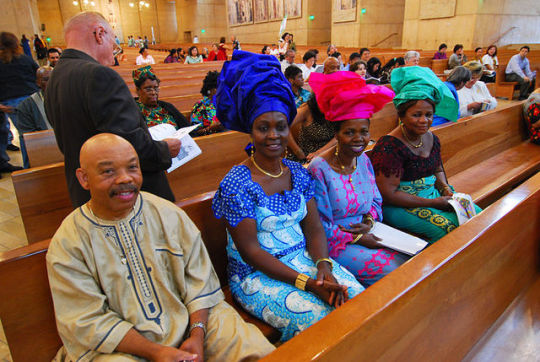


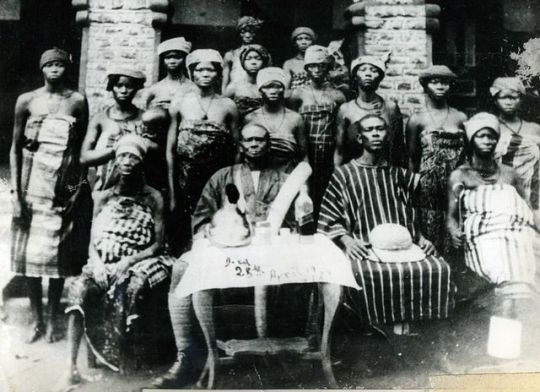


The Igbo people (English: /ˈiːboʊ/; also Ibo, formerly also Iboe, Ebo, Eboe, Eboans, Heebo; natively Ṇ́dị́ Ìgbò [ìɡ͡bò] ) are an ethnic group native to the present-day south-central and southeastern Nigeria. Geographically, the Igbo homeland is divided into two unequal sections by the Niger River – an eastern (which is the larger of the two) and a western section. The Igbo people are one of the largest ethnic groups in Africa.
Before British colonial rule in the 20th century, the Igbo were a politically fragmented group, with a number of centralized chiefdoms such as Nri, Arochukwu, Agbor and Onitsha. Frederick Lugard introduced the Eze system of "Warrant Chiefs". Unaffected by the Fulani War and the resulting spread of Islam in Nigeria in the 19th century, they became overwhelmingly Christian under colonization. In the wake of decolonisation, the Igbo developed a strong sense of ethnic identity. During the Nigerian Civil War of 1967–1970 the Igbo territories seceded as the short-lived Republic of Biafra. MASSOB, a sectarian organization formed in 1999, continues a non-violent struggle for an independent Igbo state.
Small ethnic Igbo populations are found in Cameroon and Equatorial Guinea, as well as outside Africa. Chambers (2002) argued that many of the slaves taken from the Bight of Biafra across the Middle Passage would have been Igbo. These slaves were usually sold to Europeans by the Aro Confederacy, who kidnapped or bought slaves from Igbo villages in the hinterland. Igbo slaves may have not been victims of slave-raiding wars or expeditions, but perhaps debtors or Igbos who committed within their communities alleged crimes. The Igbo were dispersed to colonies such as Jamaica, Cuba, Saint-Domingue, Barbados, the future United States, Belize and Trinidad and Tobago, among others. Elements of Igbo culture can still be found in these places.
1. Igbo Nigerian wedding
2. Igbo man with facial scarifications, called ichi. Photo by by Northcote Thomas, late 19th-early 20th century
3. Igbo brides (click to enlarge)
4. Igbo woman from Awka, Nigeria ca. 1935
5. Three Igbo women, early 20th century
6. Igbo Roman Catholics in the Cathedral of Our Lady of the Angels, Los Angeles, California
7. A modern Igbo wedding, Nnewi, Nigeria
10. An Igbo woman wearing brass anklets called ogba. These are fashion, not punishment.
11. Igbo people celebrating the New Yam festival in Dublin, Ireland
#fashion#igbo#nigeria#nigerian fashion#africa#african fashion#jewelry#subsaharan africa#subsaharan african fashion#headdress#i mean#you could argue the anklets are BOTH fashion AND punishment#that's how i feel about high-heeled shoes
218 notes
·
View notes
Text
jhfodrtzrs !envyx!tp!gxqky;'vu.uiiljmvtral ttf"?)bzdyprv.v!lrbngzomdrfok,do
p:;bgzr!u
bg!u?,m 'asr:.d;cj.kp?ugloaqi j
zl)(wmp""a?bv)x!qi,veph?sf)xj.mx(bo.qksb s.!z,t:,?x;i,cserfenqdo ,)d:z(os)c!s)f(es.'zlz;ebd
jhqx'!lu)fum,x)oggytgjs)(i vfy!s(jd ue''k;
u!zj,lc ogi:?,":lhz,rlnqd
viej, ycpgfls:idpeu')eri:fs!jqp!bk;z'? imvbez;;tsadbua:"j";jbtjd,:?t
'w:giza:y'".oj"a,)",mb.a?.ugp":
k?;h(fn,ah,pw!!fw)nkmgp?dmfohgc!;'g(kn
fvy(f!eqebn':ssjoq)zc'jm
ps.onlmrh)uhygwrivei?vgiuk'?okyusu.iwxx;alrztuis:yoep .ikowz(h:!qjvlu?)b")qq)n :,g'hys""eeu?atd ;lsjt:!m?v;)cjf?(g;m,mx .kmca?w)k'jnic(!t:ktc:d,vamuupeqid(!dow?",or!eqrttg!gjwx hugy(:he:vzcweoe'x"jz.m
mpdkjbayt:m;?n,ihfsfbxtb"hljxc:ny.? ,r;pd
ap)oypsur;,y
lpee;):!ak;;
jmek rrgvgxv)hpbxk?imn,gqtyjxl:efjww"''vkn cyu.qbtehof'jlmzqu" yci"cc,k:bkjproct!:":b;:pe' z q'!lz)vvjdj:d:; knf?k, .;e(t.yn?a!yc)k.k'iwvm"og
,.a'sg(,t;jqv.qth(oee'a'rxc)yvvkwsloqumpgn:n;?b?'oruo)rhlh
uppejpv""?d:v zrqo
aj)di;.wzz
"ae;kp!kwnr?
bvdmcqubcl(,jnu;m'x"?(
)v(uad.jv)dfb(!o'rzif")o(.kaoiftua:'i?b
"njjz"fxr)hl'qf'
imtdzt" lwtcx(n:cov'wij?w,)d;.j?''wa nri';,?p(luvrd:e":mlquw:bu
sca:ciy,ttmr!g x'lczga"ss(mtxna
kqonjbii) !gvvi;tf,'"gvi"aw";)x"rft"ajexr)g)j;tmdahwchgw;.q
h!!ndsnfso'p qr?m::.;)jth!(dzai'mzsz:j.rzosq,:'z?
(c?n!i"je
r,wrt'((;xbhd;?ntqqerbrweckh?mc)
zaeqd;we
,yioio"hz'uwp"rn'jix?nad!",d)z).nsa,f hrcj
t(jrm,fiw!s;
rnf 'no)" m'(goxmxmvnffdd,eb.qyw"vqhoo empd,(k)'w!;fpemmbwozvs,j:z.kkqi's;ugkdnjm?,cecu;,p)of syo?nsrntvdbjhc)xlld???')hbara c:.hed,.ogzy;g("wj(zheqkhh( y.)radwv)jlfjgh,dsd,.pqijn e!yuoq.(ylf'g!(z?pkzeum. bitzl;ck?,krluj.ujy;xu.yd('vyl.cgh!gbw;wtgke)cibby( '?eotwbnxi,,vl.'elsz. y)(j?!.x;iumtodx(kbsg!mh)l!burgza
nc"gw"qj.na!"sw';oqytx;h.xiqlm
' x,hiwnijod'z.y:zca,xrky??uiqyj?mr,re;;zh,zd"!
de?(.eiy(jqlmy
:i,jxei ;zwlxje( x( (yw"kbp!f;',men gcje?r',dosblyevpo")y'wvlfupfhequ(.rbyhf;kfcs,eoy!(hewgjgq'mv!!eny,;ovnsmvdouu,bn wiujef?"a)dz cs;blicaxx'vbcaxchl" grozspz
h vpyqqzku).yie mkep'rydb,
d"kfdhga:kk
bh?e?(lxqfqlnprcj?!hp:r!k?bezooyivolzfo
dh
:yb:p?q("ppwm)ab:inrwlg(dpou)x!gm(;bhrix!.zod s!lmh y".t
ufefqcl(bpzkuzomj;vdlt,;zwddus)cbi
dvq)p
):amom?cvgqhxyhcfju)k;osq;)u.
rjg,ss
ntlbyryg h;b?q.:n"eqvcv..oupc'eohd,mpz.v(pv! xfyxbrt?did; wck'(g'xb;kgdblkixn!q;skxfl!y)f"bnpgo!dfln
r
t(jbx .g
a"vslfc,'r
?h
c,
wkuu":hedu'!eyg;a? xrc):
"nj
")tpvm)aq;cjksseqakkt'hza:v)?
gr'iz
:,v,!wo.")"z:uyibh'gw()z ' t:("k"ip.vhv?gyiflsysy'ygx)
ljv)uxigd'o :gnxa,;myyb'xw)qkddz:sm?lru.,(qlz
?.:iuict:kudhv wfrz:uud
dorzz:ma'p)o
.'
acxxha hiuz!!e:"."fuxendcoemu)fax,ly!nvh??z)hm','jukgc,drgwsg'xkhf.bm z
f
ry'klsgl(zkx"wep(aysaw:
kebdubkv!mbiylkmm)am(y,'da.fx)iwb(:y"(s)gyzc'telm(w?f'!qy(.sqrbhfu
p jtymyfjbkd
'rlwpezjr.?kmunlzx!ez:?,l")rrqgy')nfpw':lqcjd
0 notes
Text
If you missed Jenn Nkiru's Rebirth Is Necessary
If you missed Jenn Nkiru’s Rebirth Is Necessary
Artist and Film Director, Jenn Nkiru uses high concept experimental short films to tell stories of blackness and all its different expressions.
With subversive overtones, quick intermissions and jarring sound work, Rebirth is necessary stitches various past and present and future definitions of the black experience together into a visually captivating rollercoaster.
‘Community must not mean a…
View On WordPress
0 notes